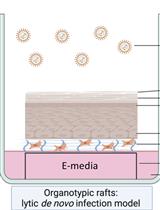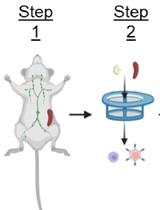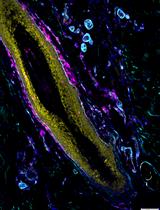- 提交稿件
- 订阅
- CN
- EN - English
- CN - 中文
- EN - English
- CN - 中文
Ex vivo Culture and Lentiviral Transduction of Benign Prostatic Hyperplasia (BPH) Samples
良性前列腺增生(BPH)样本的离体培养和慢病毒转染
发布: 2018年11月05日第8卷第21期 DOI: 10.21769/BioProtoc.3075 浏览次数: 5006
评审: Tomas AparicioAnonymous reviewer(s)
Abstract
To assess oncogenic potential, classical transformation assays are based on cell line models. However, cell line based models do not reflect the complexity of human tissues. We thus developed an inducible expression system for gene expression in ex vivo human tissues, which maintain native tissue architecture, such as epithelia and stroma. To validate the system, we transduced and expressed known tumor suppressors (p53, p33ING1b), oncoproteins (RasV12, p47ING3), or controls (empty vector, YFP) in ex vivo prostate tissues, then assessed proliferation by immunohistochemistry of markers (H3S10phos). Herein, we describe how to generate lentiviral vectors and particules, successfully transduce human prostate tissues, induce exogenous gene expression, and assess cellular proliferation.
Keywords: Ex vivo tissue culture model (离体组织培养模型)Background
Cancer afflicts all classes of society, but incidence rates increase with age. Thus, with increasing lifespan in developed countries, cancer poses an increasing burden on healthcare systems. Most investigations rely on cancer cell lines, which have defined phenotypes and genotypes, are simple to maintain in the laboratory, and usually straightforward methods are established to manipulate them (e.g., introduce genes, silence genes…). However, cells do not exist as individuals in the body, they are an integral part of tissues, which are vascularized and composed of various cell types that make cell-cell contacts and exchange signaling molecules. Thus, tissues are evidently more representative and relevant models than individual cells to study cell biology and pathologies, such as cancer.
Although several factors are involved in cancer development, such as unrepaired DNA damages, reactive oxygen species, metabolism, genomic instability, the principal model remains intact. Specifically, tumor suppressors are either silenced or mutated while oncoproteins get activated, leading to uncontrolled proliferation and cancer development.
While various cellular proliferation assays (cell counting, transformation, clonogenic, live cell imaging…) and gene expression manipulation methods are well established for cell lines, comparably reliable methods are lacking in the nascent field of ex vivo tissue models. We thus established a robust method for lentiviral transduction and inducible gene expression in ex vivo prostate tissues.
Prostate cancer (PC) is the most common UK male cancer. Most patients respond to androgen ablation therapy that targets the androgen receptor (AR), but patients invariably progress to castrate resistant PC (CRPC) for which there is no curative treatment available and where the prognosis is extremely poor (Feldman et al., 2001). Research investigating novel therapeutics and drug efficacy in PC is hampered by the lack of reliable models that reproduce the patients’ disease. Few PC cell lines are available and they only represent very late disease. Established, well-characterized cell lines (LNCaP, VCaP, DUCaP, CWR22R, PC3 and DU145) were developed from metastasis with AR mutation, amplification and AR-variant expression or even AR loss, but are not representative of early disease presentation for the majority of men where AR gene is generally unaltered (Reference 1). Additionally, cells are cultured on plastic as 2D monolayers of a homogeneous cell population and therefore lack tissue architecture and interactions of distinct cell types. The importance of the tumor microenvironment is also increasingly acknowledged with not only epithelium, but also stromal components (not represented in cell lines), which contribute to PC and CRPC development. Clinical value of using genetically engineered mouse models has the caveat that mice fail to develop PC and their prostate anatomy is dramatically different from the human prostate. Moreover, animal xenograft experiments suffer similar limitations as cell line-based investigations and are further limited by most xenografts being subcutaneously implanted and do not accurately represent complex, heterogeneous tumors. Not surprisingly therefore, there is high variability in the correlation between xenograft studies and clinical trials reported in PC (Centenera et al., 2012 and 2013). These factors substantially contribute towards the very low success rate observed in phase III clinical trials of novel PC therapeutics (significantly less than the general cancer average of 5%). Identification of new, more clinically relevant models of PC that are specific to individual PC patients would allow to improve this statistic and to address an unmet need. Thus, we have developed an ex vivo prostate tissue model to assess proliferation, but also oncogenic and tumor suppressive potential of exogenously expressed genes. These cultures can be generated from patients at all stages of disease and maintain tissue architecture, comprising both stroma and epithelial compartments, thereby retaining crucial contributory autocrine and paracrine signaling interactions.
Materials and Reagents
- Lentiviral vector generation
- pLVX Lenti-X Tet-One inducible expression system (Clontech, catalog number: 631847)
- FWDseq: taaaccagggcgcctataaa (IDT custom primer)
- REVseq: taggcagtagctctgacggc (IDT custom primer)
- BamHI (NEB, catalog number: R3136S)
- EcoRI (NEB, catalog number: R3101S)
- Calf Intestinal Alkaline Phosphatase (CIAP; NEB, catalog number: M0290S)
- Hi-fidelity DNA polymerase for PCR amplification (e.g., Platinum PCR SuperMix, Invitrogen, catalog number: 12532-016 or PfuTurbo DNA Polymerase, Agilent Technologies, catalog number: 600252)
- In-Fusion HD enzyme (Clontech, catalog number: 638910)
- QIAquick gel extraction columns (QIAGEN, catalog number: 28704)
- Ampicillin 100 mg/ml (dissolved in ddH2O and filtered sterilized)
- Small-scale plasmid DNA purification QIAprep Spin Miniprep kit (QIAGEN, catalog number: 27104)
- Large-scale plasmid DNA purification Maxi kit (QIAGEN, catalog number: 12163)
- Yeast extract
- Tryptone
- NaCl
- 2YT media (see Recipes)
- Lentiviral particules packaging
- Syringe
- 0.45 μm filters
Caution: Make sure to use low protein-binding, such as Millex-HV Filter PVDF (Millipore, catalog number: SLHVM33RS) to prevent binding of viral particules to the membrane and loss. - 100 mm culture dishes
- Amicon Ultra-15 (Millipore, catalog number: UFC903024)
- HEK293T cell line (ATCC, catalog number: CRL-3216)
- Packaging plasmids (pMD2.G and psPAX2 from Addgene, catalog numbers: 12260 and 12259, respectively) to be transformed and purified (e.g., Maxi kit, QIAGEN, catalog number: 12163)
- Transfection reagent TransIT-LT1 (Mirus MIR, catalog number: 2305)
- Dulbecco's Modified Eagle's Medium (DMEM, Sigma-Aldrich, catalog number: D6171)
- Lentiviral particules transduction and titration
- 6-well culture plates
- LNCaP cell line (ATCC, catalog number: CRL-1740)
- RPMI-1640 media (Sigma-Aldrich, catalog number: R5886)
- 200 mM L-glutamine (Invitrogen)
- Fetal calf serum (Gibco)
- Hexadimethrine bromide (Polybrene, Sigma-Aldrich, catalog number: H9268)
- Puromycin dihydrochloride (Sigma-Aldrich, catalog number: P9620)
- Crystal violet
- Induction of gene expression
- 10% ethanol
- Monoclonal ANTI-FLAG M2-Peroxidase (HRP) antibody (Sigma-Aldrich, catalog number: A8592)
- Doxycycline (Sigma-Aldrich, 10 mg/ml)
- 4% formalin
- Ex vivo tissue preparation and transduction
- Scalpels or surgical blades
- Hydrophobic pen (DAKO)
- 100% ethanol
- Media (RPMI-1640, Sigma-Aldrich, catalog number: R5886)
- Gelatin sponges (Spongostan, Johnson & Johnson, catalog number: 1364245)
- Antimycotic solution (Sigma-Aldrich, catalog number: A5955)
- 10 μg/ml hydrocortisone (Sigma-Aldrich)
- 10 μg/ml insulin solution from bovine pancreas (Sigma-Aldrich, catalog number: I0516)
- Hexadimethrine bromide (Polybrene, Sigma-Aldrich, catalog number: H9268)
- Doxycycline (10 mg/ml)
- Bovine Serum Albumin (Sigma-Aldrich)
- HRP-conjugated secondary antibodies
ImmPRESSTM HRP Anti-Rabbit IgG (Vector Laboratories, catalog number: MP-7401)
ImmPRESSTM HRP Anti-mouse IgG (Vector Laboratories, catalog number: MP-7402) - ImmPACT DAB Peroxidase (HRP) Substrate (Vector Laboratories, catalog number: SK-4105)
- Xylene
- DPX mounting media (Sigma)
- Tetracycline-free FBS (Clontech, catalog number: 631106)
- Immunohistochemistry staining for proliferation markers
- Primary antibodies for proliferation markers: H3S10phos (Millipore, catalog number: 06-570)
- Antigen Retrieval Buffer (100x Citrate Buffer pH 6.0) (e.g., Abcam, catalog number: ab93678)
- NaHCO3
- MgSO4
- Hematoxylin
- Scott's tap water substitute (see Recipes)
- Gill's Hematoxylin II solution (see Recipes)
Equipment
- Pipettes (e.g., Gilson)
- PCR machine
- CO2 incubator
- Decloaker
- Microtome to slice paraffin blocks
- Freezer
- Shaker
Software
- Aperio imaging system (https://www.leicabiosystems.com/digital-pathology/scan/)
Procedure
文章信息
版权信息
© 2018 The Authors; exclusive licensee Bio-protocol LLC.
如何引用
McClurg, U. L., McCracken, S. R., Butler, L., Riabowol, K. T. and Binda, O. (2018). Ex vivo Culture and Lentiviral Transduction of Benign Prostatic Hyperplasia (BPH) Samples. Bio-protocol 8(21): e3075. DOI: 10.21769/BioProtoc.3075.
分类
癌症生物学 > 瘤形成 > 离体组织培养模型
细胞生物学 > 组织分析 > 组织培养
细胞生物学 > 细胞工程 > 慢病毒递送
您对这篇实验方法有问题吗?
在此处发布您的问题,我们将邀请本文作者来回答。同时,我们会将您的问题发布到Bio-protocol Exchange,以便寻求社区成员的帮助。
提问指南
+ 问题描述
写下详细的问题描述,包括所有有助于他人回答您问题的信息(例如实验过程、条件和相关图像等)。
Share
Bluesky
X
Copy link












